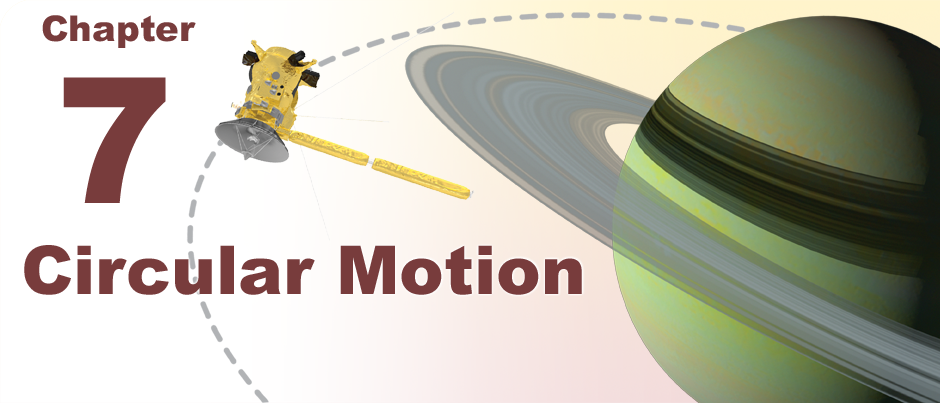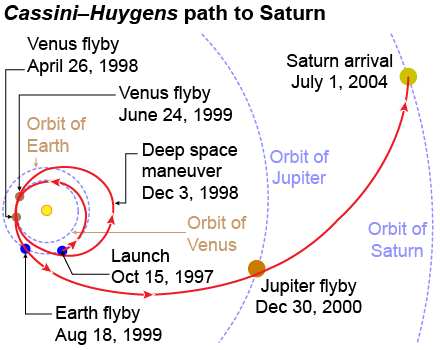 |
On October 15, 1997 a massive Titan IVB/Centaur rocket launched the Cassini–Huygens space probe toward Saturn. Once in interplanetary space, Cassini–Huygens reached speeds of 13,000 m/s or 29,000 mph. No Earth-bound vehicle comes close to this extraordinary velocity. After traveling for nearly seven years—and three and a half billion kilometers—the spacecraft successfully arrived on schedule at Saturn on June 30, 2004. The Earth orbits the Sun at a speed of 29,780 m/s, while Saturn orbits at 9,670 m/s. By comparison, a bullet travels at 240 m/s (540 mph). Cassini–Huygen’s navigators had to launch while moving 124 times as fast as a bullet, and hit a target moving 40 times as fast as a bullet, after traveling 3.5 billion kilometers. The Cassini–Huygens mission is an extraordinary feat of navigation and it required precise control of the spacecraft’s motion through time and space. 
|
 Cassini’s mission planners calculated that a direct flight from Earth to Saturn would burn too much fuel and also pass up opportunities to explore other planets. The flight engineers devised a clever but complex trajectory that included two flybys of Venus, a flyby of Earth, and a fourth flyby of Jupiter. Each flyby served two purposes. First, each was an opportunity for the spacecraft to make new scientific observations. Second, each close approach allowed a gravitational “slingshot” maneuver providing extra velocity. Only after the four “gravity assists” was Cassini–Huygens able to reach Saturn.
Cassini’s mission planners calculated that a direct flight from Earth to Saturn would burn too much fuel and also pass up opportunities to explore other planets. The flight engineers devised a clever but complex trajectory that included two flybys of Venus, a flyby of Earth, and a fourth flyby of Jupiter. Each flyby served two purposes. First, each was an opportunity for the spacecraft to make new scientific observations. Second, each close approach allowed a gravitational “slingshot” maneuver providing extra velocity. Only after the four “gravity assists” was Cassini–Huygens able to reach Saturn. 
 |
In a gravity-assist maneuver, a spacecraft is allowed to fall toward a planet, gaining speed just as a rock gains speed when you drop it. Before getting too close, the spacecraft executes a controlled sideways burn of its engines, which slightly changes the angle of approach. This allows the spacecraft to slingshot around the planet without falling into an orbit, while retaining some of the extra velocity it acquired on the way in. The exact force, timing, and direction of the engine thrust must be carefully matched to the spacecraft’s velocity vector and position; otherwise the spacecraft would end up moving in the wrong direction. A mistake of even 1/10 of one degree could mean missing the next flyby completely. 
|
How does physics help us to understand how to send spacecraft to other planets? This chapter is about how force and motion—displacement, velocity, and acceleration—work in the two-dimensional case of circular motion and orbits. The techniques of this chapter are the very same techniques that Cassini–Huygen’s engineers and scientists used to calculate and control the spacecraft over its incredible journey. 
|
| |
|

